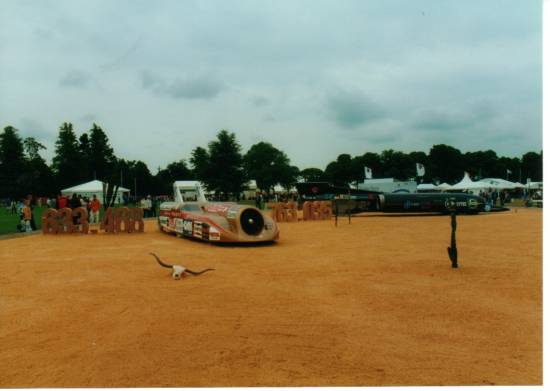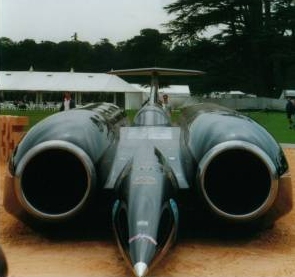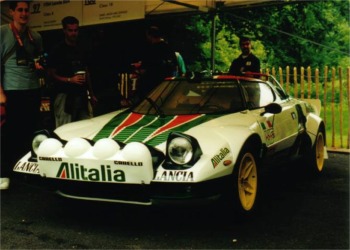The 2001 Goodwood festival of speed.

Every year at the Festival of speed Lord March introduces a theme to attract a certain style and type of car. At the 2000 festival the theme was Champions and Challengers, bringing back together the dominant cars of yesterday and today and the cars that tried to know them off of their thrones. In 2001 it was 'The Will to win' and gathered together were cars from many different manufacturers who would stop at nothing to get their cars and drivers into the winners circle. Special guest manufacturer in 2001 was Mercedes Benz, defiantly a company that has competed at the highest level in many different forms of motorsport and has a success record almost as illustrious as Alfa Romeo. Two car present at the 2000 festival that deserve a special mention proved just to large and to fast to even contemplate tackling the drive. Thrust 2 and Thrust SSC the present and previous land speed record cars, and in the case of Thrust SSC the first car to push the land speed record past the speed of sound.

 |
The scale and single mindedness of these cars is truly astounding and the skill and nerve of the driver sitting alongside one or two jet engines whilst traveling across the desert at a mile every 5 seconds is something that many of us may think we have, but in reality only a select handful of people are capable of. Seeing both of these cars together in one place is most defiantly a rare treat, especially as it was in such a rarefied arena as the Festival of speed, which is of course the single reason why both were built. |
One car and driver combination that most definitely fits into with the 2000 Festival of Speed theme of Champions and challengers is the Alfa Romeo 33TT12 which dominated the 1975 World Championship of makes. Alfa Romeo destroyed the opposition that year by taking 7 wins in 8 races with a car which had effectively started life 11 years earlier in 1964. The type, or Tipo 33 began life with a 1570cc 4 cylinder engine encased in a pretty and curvaceous body, over the coming 11 years it gained first a 2.0 litre V8 engine in 1967, a new less attractive but more effective body and 2.5 litre V8 in 1968 which became the 33/2 Daytona. For 1971 the engine grew again by 500cc to become a 3.0 litre V8 and the chassis changed from tubular steel to a sheet aluminum affair, these changes kept the car fresh enough to keep up with the opposition and claim a second place in the constructors championship.
 |
 |
 |
|
The all conquering 33TT12 from the
1975 season.
|
||
The next incarnation that we see here is the Alfa Romeo 33TT12 the pinnacle of Tipo 33 development. The 33TT reverted back to a tubular steel chassis, (TT stands for Telaio Tubolare, or tubular chassis) and a V8 engine of 3.0 litre capacity, this engine then gave way to an awesome flat 12 turbo which was later to find its way into both Brabham's and Alfa's formula one cars.
 |
 |
|
The 33TT12 on its way up the hill on
the left and in convoy with a classic Ferrari 365 GTB/4
Daytona LM and Ferrari 512S
|
|
Alfa Romeo is not the only Italian Marque to display total dominance over its rivals, in the world of rallying Lancia totally managed to destroy to opposition for many seasons firstly with the Fulvia which was introduced in 1965, the ground breaking Stratos broke cover in 1973 and officially made its homologated debut in 1974.

A break in motorsport due to group politics saw Lancia missing from the world rally scene until the 1982 season when the Lancia Rally, or more commonly called 037 was unveiled to the public. The 037 battled in the new Group B formula, but the advent of the Audi Quattro saw many of the competitive rally cars of the day instantly relegated to also rans. 4WD saw the Quattro demolish the opposition on almost all surfaces. Only the diminutive Renault 5 Turbo at the Monte Carlo prevented total German domination. So what do Lancia do to get back on the pace? They design and build possibly to most Bonkers rally (and road) car ever. A Spaceframe chassis'd mid engined 4WD supercar, certainly no half measures here, the engine powering this beast? A 1.8 litre super and Turbo charged car. The supercharger to provide boost at low engine speeds and the Turbo to take over when the mechanical inefficiencies of the Supercharger are in danger of suffocating the engine.
 |
 |
 |
|
Three views of the all conquering Lancia
Delta S4
|
||
The induction trickery, resulted in an engine that gave 450bhp, this amount of power coupled with amazing brakes and 4WD resulted in cars that redefined the way that rallys were run. Now the weak point of any Group B rally package was no longer the car, but the driver, put literally the driver could not function fast enough to keep a grip on the car, stages were taken as straight sprints interspersed with corners. As such only a couple of drivers could tame these cars Henri Toivonen in the Lancia S4 and Walter Rohl in the Audi Quattro, which by the end of the Group B era, had grown considerably shorter and more powerful, somewhere in the region of 540bhp. The golden age of Group B came to a sad and sudden end with the death of Henri Toivonen, in a high speed crash and fire. Rumors of Lancia pressuring the roll cage and filling it with Nitros Oxide have been banded about since the S4, but one thing that surely proved Lancia was more focused on speed rather than safety is the fact that the driver and co-pilot are seated above a couple of fuel tanks. In order to make the most from Group B, Lancia, Audi Peugeot and others produced rad going versions of their rally cars, detuned of course, but still pumping out around 250bhp.
 |
 |
 |
|
Road going S4
|
Very rare road going 037
|
The short wheelbase Quattro
|
With the banning of the Group B cars in 1988, many manufacturers were left without a suitable rally car, luckily Lancia had been developing the Delta HF 4WD, this car was to undergo an amazing transformation into the most successful rally car the world has know, claiming a stunning 6 consecutive world rally championships for Lancia between 1988 and 1993, along the way becoming a cult road car as well.


Page 1 2

